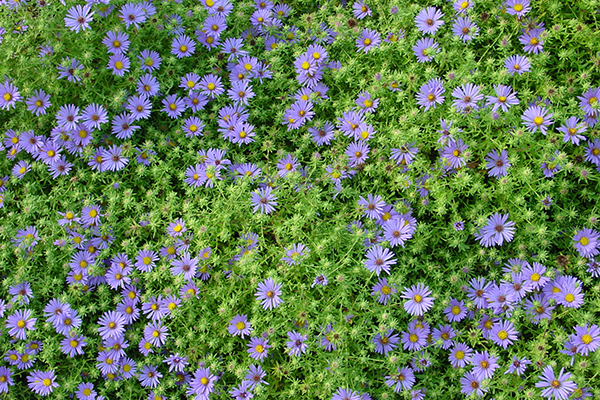
Native Delaware: Wildflowers
Fall wildflower season is in full force in Delaware
8:37 a.m., Sept. 24, 2012--The herbaceous garden at the University of Delaware Botanic Gardens is an outdoor laboratory where students and researchers study plants, insects, landscape design and plant pathology.
It’s also one of the best go-to spots for eye-popping fall color.
Campus Stories
From graduates, faculty
Doctoral hooding
Walk through the garden this month and you may encounter a student scrutinizing the Solidago rugosa 'Fireworks' for an upcoming quiz. But there’s no need to memorize the growth habits, hardiness or soil requirements of this native goldenrod cultivar to enjoy its fluffy yellow blooms.
“The herbaceous garden is one of my favorite places to see fall color,” says Sue Barton, ornamental horticulture specialist for UD Cooperative Extension. “And it looks even better this season, now that a re-design of the garden entrance is almost complete.”
Fall wildflowers are blooming earlier this year at the herbaceous garden and throughout Delaware, reports Barton. “Fall wildflowers typically start around the end of August, are in abundance now and continue through November when late-blooming asters put on a final show of color. But many species are flowering ahead of schedule this year.”
Native perennials currently in bloom at the herbaceous garden include sedums in coral, salmon and other shades of pink, says Valann Budischak, volunteer and education coordinator for the UD Botanic Gardens. Purple and lavender varieties of Eupatorium are in full flower, too. Even after the blooms are done, the seed heads still look great, notes Budischak.
Early asters also are starting to pop up, and will be followed by late varieties, such as Aster oblongifolius “Raydon's Favorite,” a showy aster that sports a profusion of blue-lavender flowers with yellow centers.
When planning for fall color in your own yard, Barton suggests thinking low as well as high. Without a doubt, many of her native fall-blooming perennials are lofty. For example, some of her New York ironweed is taller than she is – it has soared to six feet tall. Its deep purple flowers already are in bloom and will continue through the end of the month.
Although this ironweed makes an eye-catching display, Barton also likes the fall color that’s closer to the ground. Like the brilliant red foliage of Virginia creeper, a vine that can be trained to crawl, and the mottled blue-green leaves of Allegheny pachysandra, a mere six inches high.
“There are many native, low-growing groundcovers that provide great fall color,” says Barton. “Sometimes it’s the flowers that provide interest, such as the white blooms of white heath aster, which blooms from late summer into fall. In other cases, like Virginia creeper and Allegheny pachysandra, it’s the foliage that’s noteworthy.”
Groundcovers are an excellent alternative to something Barton doesn’t have much use for – mulch.
“Mulch is fine when establishing landscape beds but you should work toward having a mulch-free garden, or just small areas that are mulched. It shouldn’t be added to beds year after year,” says Barton. “Groundcovers offer the same benefits as mulch – they help regulate soil temperatures, control erosion, and help the soil retain moisture. But, unlike mulch, they also provide food and/or cover for wildlife. And you don’t have to keep buying more – groundcovers spread over time.”
Native warm-season grasses are another source of fall color that Barton utilizes widely in her yard. She especially likes the “Shenandoah” cultivar of red switch grass. In early summer, its leaves are tipped with just a bit of red but by fall the leaves are burgundy, topped by pink plumes.
Warm-season grasses are versatile. They’re well adapted to warm, sunny open spaces. Barton plants her warm-season grasses with an eye toward back lighting -- taking advantage of light from the setting or rising sun.
“Ornamental grasses look particularly beautiful when back lit – the trick is position them so the light shines through them,” says Barton.
About the UD Botanic Gardens
The 15-acre UD Botanic Gardens is open to the public free of charge, from dawn to dusk daily. It’s located on the grounds of the College of Agriculture and Natural Resources off Route 896, in Newark. Obtain a visitor parking pass online for $3 at this website or use the metered parking near the UDairy Creamery. For more info about the UD Botanic Gardens, go to the UDBG website or call 831-0153.
Article by Margo McDonough
Photo by Rick Darke








